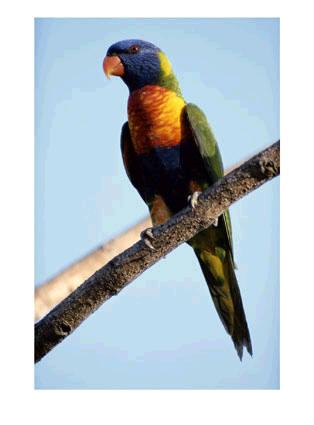Please Help Pets by Donating One Dollar
Exceptionally Beautiful
Lorikeets are Great for Pets
Lories and Lorikeets are active and curious parrots that
love to play and desire to interact with their owners
as much as possible.
The difference between Lories and Lorikeets is by tail length.
Birds with short square tails are referred to as Lories.
Those with long, pointed tails are called Lorikeets.
Lories are very vocal and some may learn to talk.
Sometimes they are good cuddlers and can even learn
some basic tricks.
Facts about Pet Lorikeets
Lorikeets live from 25 to 30 years
They are about 7 to 12" tall
With varied feather patterns of blue, yellow, red and green,
Lories are among the most colorful of all birds.
The most common kept species as pets are: rainbow, chattering,
black cap, dusky, blue streak and Goldies.
Lories and Lorikeets come from Australia, Indonesia, New Guinea
and the South Pacific.
Minimum cage size is 18"W x 22"L x 24"H
Keep cages away from drafts, open windows and the kitchen.
Lorikeets are sensitive to smoke and strong odors. Cover the
cage at night to prevent drafts.
Have perches of different widths, diameters and textures
to help keep a Lorikeet's feet healthy.
Lories and Lorikeets enjoy sleeping in nest boxes even when
they aren't breeding, so have an enclosed nest box attached
to the cage.
Lories and Lorikeets like to play and move around, a play gym
is also recommended.
They also like to bathe regularly so provide a bathtub or else
the bird will take it's bath in it's water bowl.
What to Feed Pet Lorikeets
Feed a Lorikeet 3-4 teaspoons per day of a lory pellet diet. This is a
superior alternative to feeding a commercial lory nectar formula.
About 10% of a Lorikeet's diet should be bite sized veggies like sweet
potatoes, broccoli, spinach, mustard greens, corn and shredded
carrots. Offer daily or every 2-3 days.
Small pieces of fruit such as apple, pineapple, banana, melon,
grapes, mango and pear should be 25% of your lory's daily diet.
Occasionally supplement your Lorie's diet with fruit juice, such
as natural apple juice.
Lorikeets should always have access to clean, fresh water.
Don't use tap water. We recommend Steam Distilled water
for it's purity.
Eating a large amount of fruit intake can make the droppings very fluid
Our
Recommendation for food for Lorikeets
Signs a Pet Lorikeet is Healthy
Clear, bright eyes
Clean, smooth feathers
Eats throughout the day
A curious and active disposition
Signs a Pet Lorikeet may be getting sick
Change in droppings in excess of two days
Decreased appetite; weight loss
Decreased activity and grooming behavior
Discharge from nose or mouth; sneezing
Feathers fluffed for prolonged periods of time
Sitting at the bottom of cage
Wheezing or coughing
Picture Lorikeet

Adorable Stuffed Plush Lorikeets & Birds